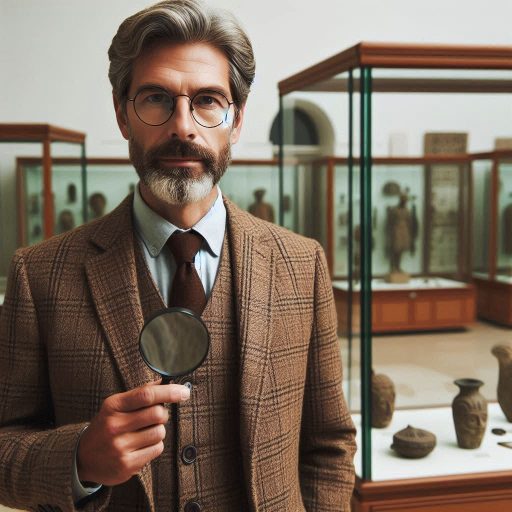Introduction
A museum curator is a professional responsible for managing collections, organizing exhibitions, and engaging the public within museums.
They oversee the care and preservation of artifacts, ensuring that these items remain accessible and in good condition for future generations.
Curators conduct extensive research to understand the historical and cultural significance of items in their collections.
They collaborate with other professionals to design educational programs and exhibitions that enhance visitors’ understanding of art, history, and culture.
This vital work fosters a deeper appreciation for cultural heritage, making curators essential to the museum experience.
Understanding museum curator salaries is crucial for those considering this career path.
Salaries for curators can vary widely based on several factors, including experience, education, institution size, and geographical location.
According to recent data, the average salary for a museum curator in the United States ranges from $45,000 to $80,000 annually.
Entry-level positions may start around $40,000, while experienced curators, especially those working in major metropolitan areas, can earn upwards of $100,000 or more.
Larger institutions often have more substantial budgets, allowing them to offer competitive salaries and benefits.
For instance, curators in well-funded museums may receive additional perks, such as health insurance, retirement plans, and opportunities for professional development.
Overview of the role of a museum curator
Responsibilities of a Museum Curator
Museum curators hold a variety of responsibilities that contribute to the successful operation of a museum.
They manage the museum’s collection, ensuring each item is properly cared for and displayed.
Curators conduct research to gather information about artifacts, artworks, and historical items.
They develop engaging exhibits that attract visitors and educate the public about the collection.
Curators also oversee the installation and deinstallation of exhibitions, coordinating with various teams to ensure everything runs smoothly.
In addition to managing collections, curators often engage in community outreach to promote the museum’s mission.
They may lead tours, give lectures, and organize special events to connect with visitors.
Skills and Qualifications Required for the Job
To become a museum curator, individuals typically need a relevant degree, such as art history, archaeology, or museum studies.
Many curators hold advanced degrees, which enhance their expertise and job prospects.
Strong research and organizational skills are crucial for curators, as they manage large collections and perform detailed research.
Attention to detail is vital when working with artifacts, ensuring their preservation and proper handling.
Curators also require excellent communication skills to effectively convey complex information to diverse audiences.
Interpersonal skills are equally important, as curators collaborate with other museum staff, donors, and community members.
Experience through internships or volunteer work in museums provides valuable practical skills and networking opportunities.
Importance of Curators in the Preservation and Presentation of Art and Artifacts
Curators play a critical role in the preservation and presentation of art and artifacts.
They are responsible for maintaining the integrity of collections, ensuring items are protected from damage.
Curators work closely with conservation experts to develop preservation strategies for fragile items.
This dedication to preservation ensures that future generations can appreciate the cultural and historical significance of these objects.
In addition to preserving items, curators enhance public understanding through thoughtful presentation.
They design exhibits that tell compelling stories, connecting visitors to the past.
Curators interpret artifacts and artworks, providing context that enriches the visitor experience.
By fostering an appreciation for art and history, curators contribute to the museum’s educational mission.
Their efforts promote cultural awareness and encourage dialogue among diverse communities.
Museum curators hold significant responsibilities that impact both the museum’s operations and its public engagement.
They require a mix of skills and qualifications to manage collections effectively.
Their vital role in preserving and presenting art and artifacts ensures that cultural heritage remains accessible and relevant.
As a result, museum curators significantly influence how we understand and appreciate our shared history.
Read: How to Create Memorable Characters: Pro Tips
Factors that influence museum curator salaries
Location of the Museum
The location of a museum significantly impacts a curator’s salary.
Urban areas often offer higher salaries due to increased living costs and competition.
For example, museums in cities like New York or San Francisco tend to pay more than those in rural regions.
High-cost living areas also attract larger audiences, leading to increased funding and resources.
Curators in metropolitan museums may earn higher salaries due to more extensive collections and diverse programs.
Conversely, smaller towns might have limited budgets, resulting in lower salaries for curatorial positions.
However, smaller museums can provide unique opportunities and experiences that larger institutions may not offer.
Size and Prestige of the Museum
The size and prestige of the museum also play crucial roles in determining salaries.
Major museums with extensive collections and high visitor numbers can afford to pay curators more.
These institutions often have larger budgets and more significant funding from grants or donations.
Prestigious museums may also offer additional benefits, such as bonuses and professional development opportunities.
In contrast, smaller or lesser-known museums typically operate with tighter budgets.
They may offer lower salaries but can provide valuable hands-on experience and opportunities for advancement.
Curators at prestigious institutions often enjoy enhanced visibility in the field, which can lead to further career opportunities.
Experience and Education Level of the Curator
A curator’s experience and education level greatly influence their earning potential.
Curators with advanced degrees, such as a master’s or doctorate, tend to command higher salaries.
Specialized training in art history, anthropology, or museum studies can enhance employability.
Entry-level curators may start with lower salaries, but their earnings typically increase with experience.
Curators with several years of experience can expect to earn significantly more than their less experienced counterparts.
Senior curators or those in leadership positions often earn salaries reflective of their extensive expertise and responsibilities.
Continuous professional development can further boost a curator’s earning potential.
Demand for Curators in the Job Market
The demand for curators in the job market directly impacts salary expectations.
As museums expand their offerings and audiences grow, the need for skilled curators increases.
Curators play essential roles in creating engaging exhibits and educational programs, making them valuable assets to institutions.
However, competition for curator positions can be intense, particularly in prestigious museums.
Emerging trends, such as digital curation and online exhibits, create new opportunities and challenges in the field.
These trends can influence salary structures as museums adapt to changing audience needs.
Curators with skills in technology and social media may find increased demand, leading to higher salaries.
Therefore, curators can expect their salaries to vary based on location, museum size, experience, and market demand.
By understanding these factors, aspiring curators can better navigate their career paths and financial expectations.
Read: Ceramic Art Exhibitions to Visit in 2024
Average salary range for museum curators
Statistics on Median Salaries for Curators
Understanding the salary landscape for museum curators is essential for aspiring professionals.
According to recent data, the median salary for curators in the United States is around $58,000 per year.
This figure can vary based on several factors, including experience, education, and the size of the institution.
Entry-level curators may start with salaries around $40,000, while those with significant experience can earn over $80,000 annually.
Salaries may also differ based on specific museum functions, such as exhibition management or education.
Discrepancies in Salaries Based on Location and Museum Type
Location plays a significant role in determining curator salaries.
Curators working in large metropolitan areas often earn higher salaries than those in rural settings.
For example, curators in cities like New York or San Francisco typically earn more than those in smaller towns.
Additionally, the type of museum influences salary levels.
Art museums and large institutions usually offer higher salaries compared to smaller historical museums or local galleries.
Curators in specialized fields, such as science or technology museums, may also see varying compensation.
Overall, the salary landscape reflects both regional economic conditions and the financial health of specific institutions.
Potential for Salary Growth with Experience and Expertise
While entry-level salaries may seem modest, there is significant potential for salary growth in the curator profession.
With experience, curators can advance to senior roles, such as head curator or director, which often come with increased responsibilities and higher pay.
Building expertise in a specialized area, such as art history or conservation, can also lead to higher salaries.
Many museums reward curators who contribute to successful exhibitions or educational programs, recognizing their efforts with salary increases or bonuses.
Continuing education and professional development also play a critical role in enhancing earning potential.
Curators who pursue advanced degrees or specialized training often qualify for higher-paying positions.
Networking within the museum community can open doors to new opportunities and increase marketability.
In review, museum curators can expect median salaries around $58,000, with discrepancies based on location and museum type.
Entry-level salaries may start lower, but significant growth potential exists with experience and expertise.
As curators gain knowledge and take on more responsibilities, they can achieve higher compensation levels.
Understanding these salary dynamics can help aspiring curators set realistic career expectations and pursue paths that enhance their professional value.
Ultimately, dedication to career development and a commitment to the museum field can lead to a rewarding and fulfilling career with competitive financial benefits.
Read: Character Design Trends: What’s Hot in 2024?

Benefits and Perks of Being a Museum Curator
Opportunities for Professional Development
A career as a museum curator offers numerous opportunities for professional development.
Many museums support their curators in pursuing further education and training.
Curators often attend workshops, conferences, and seminars to expand their knowledge and skills.
These events allow curators to learn about new trends and techniques in curation and conservation.
Networking with other professionals can lead to valuable collaborations and partnerships.
Additionally, curators can engage in research projects that enhance their expertise in specific areas of art or history.
Many museums also encourage curators to publish their findings in academic journals, contributing to the field’s body of knowledge.
This ongoing professional development can significantly impact a curator’s career growth and earning potential.
Access to Unique Art and Artifacts
Museum curators enjoy access to unique art and artifacts that few people ever experience.
They work closely with invaluable pieces, handling them regularly and learning their histories.
This access deepens a curator’s appreciation for cultural heritage and artistic expression.
Curators often oversee the acquisition of new items, expanding the museum’s collection and enhancing its offerings.
They may travel to source rare artifacts, collaborating with artists, collectors, and other institutions.
This aspect of the job adds excitement and variety to their daily tasks.
Furthermore, curators can also participate in the installation of exhibits, allowing them to creatively display and interpret items.
This firsthand experience with unique objects enriches a curator’s professional life and fuels their passion for their work.
Fulfilling Work in Preserving Cultural Heritage
Working as a museum curator provides fulfilling opportunities to preserve cultural heritage.
Curators play a critical role in ensuring that historical artifacts and artworks are protected for future generations.
They carefully research, document, and maintain collections, ensuring proper care and conservation.
This work helps safeguard the stories and significance of diverse cultures and communities.
Many curators find great satisfaction in educating the public about these items through exhibitions and programs.
They inspire visitors to appreciate the richness of human history and creativity.
Curators often feel a strong sense of purpose in their roles, knowing they contribute to cultural preservation and education.
This fulfillment enhances their job satisfaction and can lead to a greater commitment to their career.
The role of a museum curator offers a unique blend of professional development, access to extraordinary art, and fulfilling work.
Opportunities for continuous learning and networking pave the way for career advancement.
Curators enjoy exclusive access to remarkable artifacts, deepening their appreciation for cultural heritage.
The work of preserving and educating about these treasures provides profound job satisfaction.
Ultimately, the life of a curator not only shapes their career but also enriches the cultural landscape for everyone.
The museum profession rewards those passionate about art, history, and community engagement, making it a worthwhile pursuit.
Read: How to Price Your Ceramic Artwork
Challenges faced by museum curators in terms of salary
As museum curators navigate their careers, they encounter various challenges related to their salaries.
In this section, we will delve into the specific obstacles that museum curators face in terms of compensation.
Transform Your Career Today
Unlock a personalized career strategy that drives real results. Get tailored advice and a roadmap designed just for you.
Start NowLimited job opportunities in certain locations
Museum curators may find themselves restricted by the lack of job opportunities in specific geographical locations.
Museums are often concentrated in urban areas, leaving curators in rural or less populated areas with limited options for employment.
This geographical disparity can impact the salary prospects for museum curators, as they may have to compromise on compensation to secure a position in a limited job market.
Competition for curator positions
The field of museum curation is highly competitive, with a limited number of curator positions available compared to the number of qualified professionals seeking employment.
This intense competition can lead to lower salary offers for museum curators, as organizations may leverage the surplus of candidates to negotiate lower compensation packages.
Additionally, the abundance of applicants vying for coveted curator roles can create challenges for individuals attempting to secure competitive salaries in the industry.
Struggles in negotiating salaries in the museum sector
Museum curators often face challenges when negotiating salaries within the museum sector.
Unlike other industries where salary negotiations are common practice, the nonprofit nature of many museums can make it difficult for curators to advocate for higher compensation.
Additionally, budget constraints within museums may restrict their ability to offer competitive salaries to curatorial staff.
As a result, museum curators may find themselves in a challenging position when trying to negotiate fair and competitive compensation packages.
Ultimately, museum curators encounter various challenges related to their salaries, including limited job opportunities in certain locations, competition for curator positions, and struggles in negotiating salaries within the museum sector.
Despite these obstacles, museum curators continue to play a vital role in preserving and promoting cultural heritage through their work in museums and cultural institutions.
Strategies for increasing museum curator salaries
Pursuing Additional Education and Certifications
One way to increase your museum curator salary is by investing in your education and obtaining relevant certifications.
By acquiring advanced degrees in fields such as museum studies, art history, or anthropology, you can demonstrate a higher level of expertise and qualifications, which can lead to salary raises and promotions.
Additionally, obtaining specialized certifications in areas like collection management or exhibition design can make you a more attractive candidate for higher-paying positions within the museum industry.
Seeking out Opportunities for Advancement within the Field
Another effective strategy for boosting your museum curator salary is by actively seeking out opportunities for advancement within the field.
Consider taking on leadership roles within your organization.
You might become a department head or project manager.
Alternatively, pursue advancement opportunities at other museums or cultural institutions.
By demonstrating your leadership abilities and willingness to take on new challenges, you can position yourself for salary increases and career growth.
Networking with Other Curators and Museum Professionals
Networking with other curators and museum professionals can also play a key role in increasing your salary as a museum curator.
Build relationships with industry colleagues to expand your network.
Attend professional development events to enhance your skills and knowledge.
Join organizations like the American Alliance of Museums for valuable resources.
Stay informed about job opportunities and salary trends through these connections.
Learn best practices in the field by engaging with other professionals.
Additionally, networking can help you build a strong reputation within the industry, making you a more desirable candidate for well-compensated curator positions.
Conclusion
Being a museum curator is a crucial role that plays a significant part in preserving our cultural heritage.
Curators are the guardians of our past, present, and future, ensuring that history is accurately recorded and passed down to future generations.
They act as storytellers, educators, and advocates for the importance of art, history, and culture.
For aspiring curators, it’s essential to remember that passion and dedication to the field are invaluable.
While the salary may not always be lucrative, the reward of working with priceless artifacts, engaging with diverse audiences, and contributing to the preservation of history is immeasurable.
Pursuing your passion as a curator can lead to a fulfilling and impactful career.
As members of the public, we support museums and cultural institutions by visiting exhibits and attending events.
We can also donate to help fund their conservation efforts.
Engaging with these institutions shows our appreciation for the work of curators.
Our participation helps preserve cultural heritage for future generations.
Supporting museums benefits both the community and the curatorial profession.
By showing our appreciation for the hard work and dedication of curators, we contribute to the continued success and sustainability of cultural institutions worldwide.
[E-Books for Sale]
The Big Book of 500 High-Paying Jobs in America: Unlock Your Earning Potential
$19.99 • 500 High-Paying Jobs • 330 pages
Explore 500 high-paying jobs in America and learn how to boost your career, earn more, and achieve success!
See All 500 High-Paying Jobs of this E-Book
1001 Professions Without a Degree: High-Paying American Jobs You Can Start Now
$19.99 • 1001 Professions Without a Degree • 174 pages
Discover 1001 high-paying jobs without a degree! Unlock career tips, skills, and success strategies for just $19.99!




